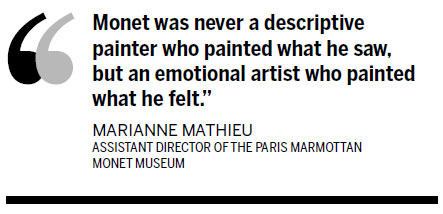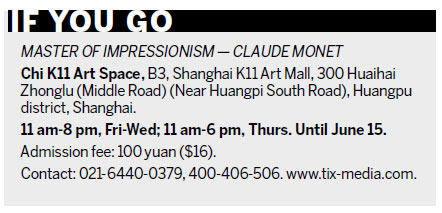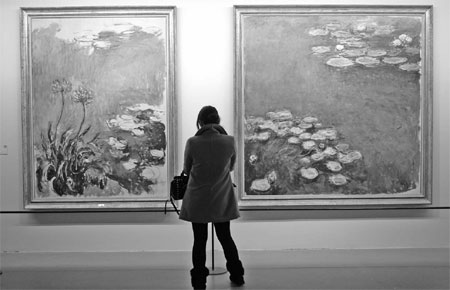A door to monet's life
Updated: 2014-03-16 08:11
By Wu Yiyao(China Daily)
|
|||||||
When masterpieces are exhibited in a shopping center, the chemistry can be right if one look at its charms appeals to tens of thousands of visitors who have booked tickets days in advance to have a look at Monet's life story. Wu Yiyao reports in Shanghai.
The first ever exhibition of Claude Monet's works on the Chinese mainland is ongoing at Shanghai K11's Chi Space. On show are 40 masterpieces of the great Impressionist, spanning from his childhood sketches to the art created during his last days, together with 12 works from Monet's friends, all Impressionist masters of his time.
All of the works exhibited are from the Paris Marmottan Monet Museum, which is also the home of many of Monet's works bequeathed by his son Michel Monet.
When asked how the current exhibition is different from recent shows featuring Impressionistic works in China, Marianne Mathieu, assistant director of the Paris Marmottan Monet Museum, says: "The exhibition opens a door for visitors to see Monet's life and his home, drawing visitors closer to Monet's inner world."
Wang Xiaoye, a 32-year-old visitor, says: "It is interesting to see Monet and his friends paint each other and their family members. It is not only evidence of the close friendship between the artists, but also a presentation of the masters' skills and their perspectives of life."
Alongside Monet's famous Water Lily series, four paintings themed Japanese Bridge are presented. Based on a bridge in the painter's garden, the four paintings were done between 1818 and 1819. They are similar in size but totally different in colors, shades and light, a vivid description of Monet's Impressionism.
"The key way to appreciate and understand Monet's paintings is to know his way of painting ... That is, to capture a moment of light and color in nature," Mathieu says. To put it clearer, it is not to see what he painted, but see how he painted.
"Monet was never a descriptive painter who painted what he saw, but an emotional artist who painted what he felt."
Monet often worked on several paintings at the same time or worked on the same painting at different times. Some of his works leave irregular blanks on the margin, causing criticism from his contemporaries that he should not have sold or exhibited "incomplete" works.
Monet's painting with margins shows his wish to remain attuned to nature, according to Mathieu, which itself is never to be finished in its work. By renouncing completeness, he captures an aspect of nature that is open to infinity.
"Coincidentally, this kind of infinity is relevant to Asian art and culture, especially Chinese landscape paintings. Upon viewing many of these works, many Chinese visitors will easily see a connection with Chinese landscape paintings (with a margin left for viewers' imagination)," Mathieu says.

Organizers say they decided to hold the exhibition at Chi Space of Shanghai K11 because they would like to attract people who don't usually visit museums, which in return helps the box office.
"As we work toward our vision and mission to advance the development of Chinese contemporary arts and bring it to a broader audience at home and abroad, we are constantly inspired by our current and past experiences as well as those of the great masters before like Monet," says Adrian Cheng, founder and chairman of the K11 Art Foundation.
"We hope that Monet's bold and innovative spirit to break away from the 19th-century salon art, which the Impressionism movement is born out of, will stimulate young Chinese artists, students of arts and our community to experiment and create their own movement."
The operating costs behind the exhibition became a major concern when it came to deciding the venue of the exhibition.
As a private cultural industry enterprise, if we had chosen a government-subsidized art museum, the admission fee could be either free or too low to cover the cost of bringing the exhibition to China, says Jin Xiaojing, communication officer with Tix-Media, the company that organized the exhibition.
By March 9, about 70,000 tickets were booked and passionate visitors lined up for two hours outside the Chi Space to view the Impressionism master's works.

Zhang Nan, a 22-year-old student came all the way from Ningbo, 300 kilometers from Shanghai, to see the paintings.
He says the two-hour wait for admission and the 100-yuan ($16) admission fee were worthwhile because the exhibition gives him something "you can never find anywhere else".
He is impressed with Monet's sketches, the comic portraits he did when he was a teenager.
"I have never seen these works before in any other exhibition or album," he says.
"The works show that Monet was talented when he was still a teenage boy. It is quite impressive to see these works and to know his past, the past prior to the well-known Monet in our textbooks."
Contact the writer at wuyiyao@chinadaily.com.cn.
|
Claude Monet's works are on show at Shanghai K11's Chi Space, including his childhood sketches and pieces created during his last days. Gao Erqiang / China Daily |

(China Daily 03/16/2014 page9)
